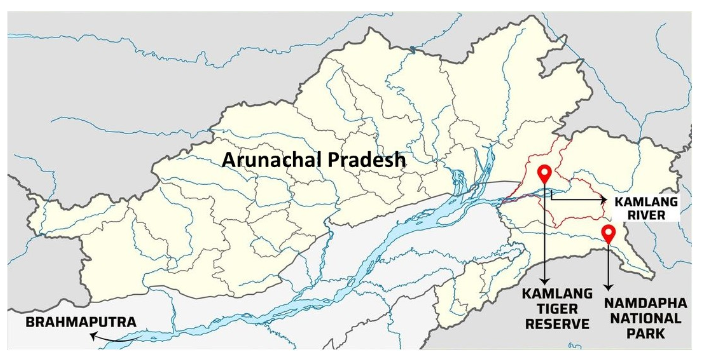11 Nov 2024 10:53:15 am
Environmental Ecology
Eco-Sensitive Zones
Tags :
Eco-Sensitive Zones

Topic: Conservation
Why in the news?
- The Ministry of Environment, Forest and Climate Change has declared Arunachal Pradesh\'s Namdapha National Park & Tiger Reserve and Kamlang Wildlife Sanctuary & Tiger Reserve as Eco-Sensitive Zone (ESZ).
- The Namdapha National Park & Tiger Reserve is in Changlang district, while the Kamlang Wildlife Sanctuary & Tiger Reserve falls in Lohit district.
Source: India Today
About Eco-Sensitive Zones:
- As per the National Wildlife Action Plan (2002-2016), issued by the Union Ministry of Environment, Forest and Climate Change, land within 10 km of the boundaries of national parks and wildlife sanctuaries is to be notified as eco-fragile zones or Eco-Sensitive Zones (ESZ).
- While the 10-km rule is implemented as a general principle, the extent of its application can vary. Areas beyond 10-km can also be notified by the Union government as ESZs, if they hold larger ecologically important “sensitive corridors”.
- According to the guidelines issued by the Environment Ministry in 2011, Eco-Sensitive Zones are created as “shock absorbers” for the protected areas, to minimize the negative impact on the “fragile ecosystems” by certain human activities taking place nearby.
- These areas are meant to act as a transition zone from areas requiring higher protection to those requiring lesser protection.
- They are not meant to hamper the daily activities of people living in the vicinity, but are meant to guard the protected areas and refine the environment around them.
- Activities prohibited in Eco-Sensitive Zones include commercial mining, saw mills, commercial use of wood, etc., apart from regulated activities like felling of trees.
- On the other hand, ongoing agricultural or horticultural practices, rainwater harvesting, organic farming, etc. are permitted in Eco-Sensitive Zones.
- India has more than 600 Ecologically Sensitive Zones declared across different states.
Namdapha National Park & Tiger Reserve:
- It is located in Arunachal Pradesh, surrounded by Myanmar in the Southeast.
- It is located at the junction of the Indian Sub-Continent Biogeographic Region and the Indo-China Biogeographic Region. As a result of this, extensive diversity of flora and fauna is observed in this belt.
- It is wedged between the Dapha Bum ridge of Mishmi Hills, of North Eastern Himalayas and the Patkai Ranges.
- It has a common boundary with Kamlang Wildlife Sanctuary and Nampong Forest Division on the south-western side of Arunachal Pradesh.
- The park spans a wide altitudinal range from 200 m to 4,571 m at Dapha Bum, the highest point in the park.
- It encompasses evergreen Forests, Moist deciduous forests, subtropical forests, temperate and alpine forests.
- Flora:
- As many as 150 timber species are found here, with species like Pinus Merkusi and Abies Delavavi being exclusive to the park.
- Blue Vanda, a rare and endangered orchard, is also found here.
- Mishimi Teeta, a medicinal plant used by local tribes to treat different types of diseases, is also found here.
- Fauna:
- It is the only park in the World to have the four Feline species of big cat namely the Tiger, Leopard, Snow Leopard, and Clouded Leopard, and numbers of Lesser cats.
- It is home to Hoolock Gibbons, highly endangered and only ‘ape’ species found in India.
- Other animals found here include elephants, black bear, Indian Bison, pig-tailed macaque, several species of deers, reptiles and a variety of arboreal animals.
Kamlang Wildlife Sanctuary & Tiger Reserve:
- It is located in the southeastern part of Arunachal Pradesh near the border with Myanmar.
- It is named after Kamlang River, which flows through the reserve and joins Brahmaputra.
- It is spread between Namdapha National Park on its south and Lang River on its north.
- The local inhabitants are Hishmi, Digaru and Mizo.
- It encompasses a diverse range of landscapes, including dense tropical forests, grasslands, rivers, and hills.
- It enjoys a sub-tropical climate as it falls within the sub-tropical zone.
- The lower reaches and foothills of the region are covered with tropical wet evergreen forests, while the alpine vegetation dominates the higher altitudes.
- Flora:
- Common species of trees include Amari, Gamari, Hillika, Dhuna etc.
- Fauna:
- All four big cats, including the Snow Leopard, Clouded Leopard, Leopard and Tiger, are the common inhabitants.
- Himalayan Palm Civets, Leopard Cat, Slow Lories, Hoolock Gibbon Giant and Flying Squirrels, Hornbills, Deer, Civets, Boar, Capped Langur, Stump Tailed Macaque etc. can be spotted here.

